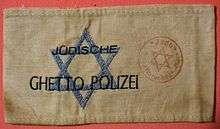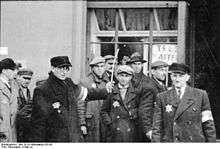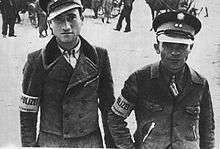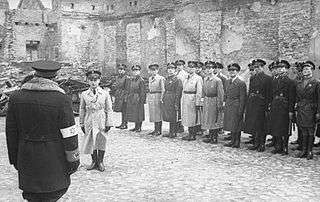Jewish Ghetto Police

The Jewish Ghetto Police or Jewish Police Service (German: Jüdische Ghetto-Polizei or Jüdischer Ordnungsdienst), also called the Jewish Police by Jews, were auxiliary police units organized within the Jewish ghettos of German-occupied Poland by local Judenrat (Jewish council) collaborating with the German Nazis.[1]
Overview


Members of the Jüdischer Ordnungsdienst at first did not have official uniforms, often wearing just an identifying armband, a hat, and a badge, and were not allowed to carry firearms, although they did carry batons. They were used by the Germans primarily for securing the deportation of other Jews to the concentration camps, but their work encompassed all forms of public order in the ghetto. The Jewish ghetto police distinguished themselves from the Polish Blue Police by their shocking corruption and immorality.[2]

The Jüdischer Ordnungsdienst were recruited from two separate groups, who could be relied upon to follow German orders. The first were Jewish lawyers, disbarred by the German occupiers, largely recruited by deputy commander Jakub Lejkin, himself later executed by the Jewish Resistance. The second, larger and more criminally active group, were recruited from among pre-War Jewish organised crime groups.[1] The first commander of the Warsaw ghetto was Józef Szeryński, a Jewish lieutenant-colonel in the pre-War Polish Police. He changed his name from Szenkman and developed an anti-Semitic attitude.[3] Szerynski survived an assassination attempt carried out by a member of the Jewish police, Yisrael Kanal, who was working on behalf of the underground Jewish Combat Organization. In ghettos where the Judenrat was resistant to German orders, the Jewish police were often used (as reportedly in Lutsk) to control or replace the council.[1]
The criminal elements in the Ordnungsdienst soon came to dominate several areas of life in the ghetto, notably the transportation of people and goods. Additionally, there was a secret department, Section 13, known as the "Jewish Gestapo". It specialised in tracking down Jewish people outside the Ghetto walls, as well as their Polish helpers, and often profited by extorting them.
One of the largest Jewish police units was to be found in the Warsaw Ghetto, where the Jüdischer Ordnungsdienst numbered about 2,500. The Łódź Ghetto had about 1,200, and the Lwów Ghetto 500.[4]
Anatol Chari, a policeman in the Łodz Ghetto, in his memoirs describes his work protecting food depots, controlling bakery employees, as well as patrols aimed at the confiscation of food from the Ghetto residents. He recounts the involvement of Jewish Policemen in swindling food rations and in forcing women to provide sexual services in exchange for bread.[5]
The Polish-Jewish historian and Warsaw Ghetto archivist Emanuel Ringelblum has described the cruelty of the ghetto Jewish police as "at times greater than that of the Germans, the Ukrainians and the Latvians."[6] The Jewish ghetto police ultimately shared the same fate with all their fellow ghetto inmates. On the ghettos' liquidation (1942-1943) they were either killed on–site or sent to extermination camps. However, some of the more active collaborators, especially those associated with the Żagiew network, are known to have survived the war.
See also
References
- 1 2 3 "Judischer Ordnungsdienst". Museum of Tolerance. Simon Wiesenthal Center. Retrieved 2008-01-14.
- ↑ Ringelblum, Emmanuel (2015-11-06). Notes From The Warsaw Ghetto: The Journal Of Emmanuel Ringelblum. Pickle Partners Publishing. ISBN 9781786257161.
- ↑ "Warsaw Ghetto". www.deathcamps.org.
- ↑ Raul Hilberg: The Destruction of the European Jews, Quadrangle Books, Chicago 1961, p. 310.
- ↑ Chari, Anatol. Podczłowiek. Wspomnienia członka Sonderkommanda. Świat Książki. ISBN 978-83-7799-523-5.
- ↑ Collins, Jeanna R. "Am I a Murderer?: Testament of a Jewish Ghetto Policeman (review)". Mandel Fellowship Book Reviews. Kellogg Community College. Retrieved 2008-01-13.
Further reading
External links
| Wikimedia Commons has media related to Jewish Ghetto Police. |